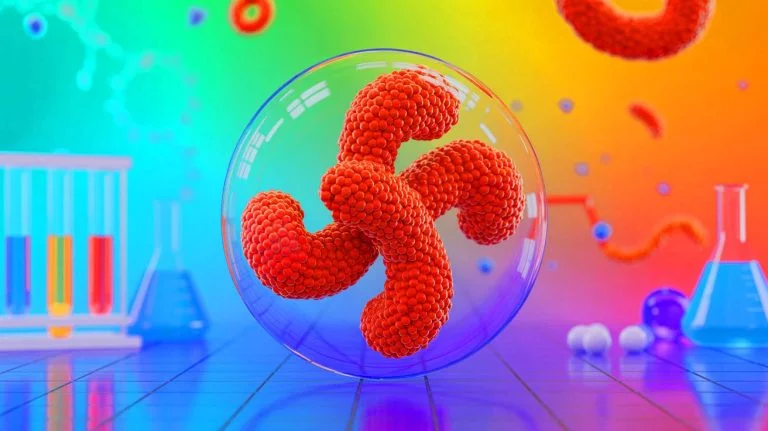| IN A NUTSHELL |
|
In a groundbreaking development, scientists at Johns Hopkins Medicine have made significant strides in understanding how cells move by building a minimal synthetic cell. This synthetic cell can follow external chemical cues, demonstrating a fundamental biological process known as “symmetry breaking.” The research, published in Science Advances, presents a new way to mimic and potentially control how cells respond to their environment. Such advancements may pave the way for novel drug delivery systems that can precisely target specific areas within the body. The study’s implications extend beyond biology, touching on fields as diverse as physics and cosmology.
Understanding Symmetry Breaking
Symmetry breaking is a critical precursor to cell movement. It occurs when a cell’s molecules, initially symmetrically arranged, reorganize into an asymmetric pattern in response to stimuli. This process can be likened to the way migrating birds change formation based on environmental cues like sunlight. For cells, symmetry breaking is essential for responding to chemical signals, such as those at an infection site. This reorganization allows immune cells to traverse blood vessel walls and reach infected tissues. The transformation into polarized and asymmetric structures prepares them to move toward their target.
Shiva Razavi, Ph.D., who led the research, emphasizes the importance of symmetry breaking across multiple scientific disciplines. “The notion of symmetry breaking is crucial to life, impacting fields as diverse as biology, physics and cosmology,” Razavi explains. Understanding this process is vital for uncovering the fundamentals of biology and developing new therapeutic strategies. By mimicking and controlling symmetry breaking in synthetic cells, scientists hope to gain insights into how cells survey their chemical environment and adapt accordingly.
The Creation of a Synthetic Cell
The researchers constructed a giant vesicle with a double-layered membrane, creating a simplified synthetic cell or protocell. This cell, composed of phospholipids, purified proteins, salts, and ATP, is designed to mimic the first step in an immune response. In their experiments, scientists engineered the protocell to detect chemical signals, prompting it to break symmetry. This change allows the cell to transform from a perfect sphere to an uneven shape, preparing it for movement.
“Our study demonstrates how a cell-like entity can sense the direction of an external chemical cue, mimicking the conditions you would find in a living organism,” Razavi states. By building this cell-like structure from scratch, researchers can identify and understand the essential components required for symmetry breaking. This understanding is crucial for developing future applications in medicine and beyond.
Potential Applications in Medicine
The ability to mimic symmetry breaking in synthetic cells holds promise for targeted drug delivery. According to senior author Takanari Inoue, Ph.D., “The idea is that you can package anything you want into these bubbles—protein, RNA, DNA, dyes or small molecules—tell the cell where to go using chemical sensing, and then have the cell burst near its intended target so that a drug can be released.” Such precision in drug delivery could revolutionize treatments for various diseases, allowing for more effective and less invasive therapies.
The researchers activated the vesicle’s chemical-sensing ability by planting two proteins, FKBP and FRB, within the synthetic cell. When exposed to the chemical rapamycin, these proteins triggered a process known as actin polymerization. This reorganization of the synthetic cell’s skeleton resulted in a rod-like structure that exerted pressure on the cell membrane, causing it to bend. This process illustrates the potential for synthetic cells to respond to specific chemical signals, opening the door for new medical applications.
Future Directions and Challenges
The researchers plan to enhance these synthetic cells further, equipping them with the ability to move toward desired targets. By doing so, they hope to create synthetic cells capable of targeted drug delivery, environmental sensing, and other applications where precise movement is crucial. The development of such technology could have far-reaching implications, not only in medicine but also in fields that require responsive and adaptive systems.
Despite the promising results, challenges remain. The complexity of replicating natural cellular processes in synthetic systems requires continued research and innovation. Collaborations between scientists from various disciplines will be essential to overcome these hurdles and realize the full potential of synthetic cells. The research team, supported by funding from several prestigious institutions, is committed to advancing this field and exploring new possibilities for synthetic biology.
As scientists continue to explore the capabilities of synthetic cells, questions remain about their potential applications and limitations. Will these advancements lead to safer and more effective medical treatments, or will they introduce new ethical and technical challenges? The future of synthetic biology promises both exciting opportunities and complex dilemmas that researchers must navigate thoughtfully.
Did you like it? 4.4/5 (26)








Wow, synthetic cells that can change shape? Sounds like something out of a sci-fi movie! 🧬
Can these synthetic cells be used for environmental cleanup, like breaking down pollutants?
I’m curious about the ethical implications. Are there any risks involved with this technology?
Thank you for sharing such an exciting breakthrough in synthetic biology! 🙌
How soon do you think this technology could be used in real-world medical treatments?
Is there a possibility of these cells evolving beyond our control?
Gr8 article, but how do they ensure the synthetic cells don’t trigger unintended immune responses?
So basically, we’re creating cells that can think for themselves? Terrifying or amazing? 🤔
Is this the first step towards creating fully synthetic life forms?
What are the main challenges the researchers are facing with this technology?
This study is a game-changer for drug delivery systems. Can’t wait to see more! 🚀